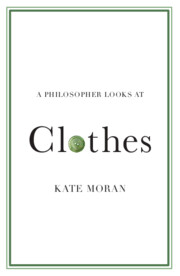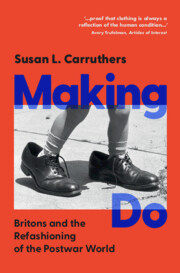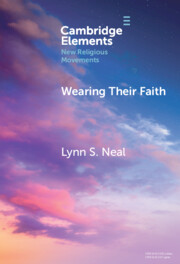Refine search
Actions for selected content:
45 results
Afterword
-
- Book:
- Irish Romanticism
- Published online:
- 27 November 2025
- Print publication:
- 11 December 2025, pp 164-181
-
- Chapter
- Export citation

A Philosopher Looks at Clothes
-
- Published online:
- 08 May 2025
- Print publication:
- 05 June 2025

Making Do
- Britons and the Refashioning of the Postwar World
-
- Published online:
- 24 April 2025
- Print publication:
- 24 April 2025
Epilogue
-
- Book:
- Making Do
- Published online:
- 24 April 2025
- Print publication:
- 24 April 2025, pp 292-293
-
- Chapter
- Export citation
5 - Germans
-
- Book:
- Making Do
- Published online:
- 24 April 2025
- Print publication:
- 24 April 2025, pp 165-201
-
- Chapter
- Export citation
Conclusion
-
- Book:
- Making Do
- Published online:
- 24 April 2025
- Print publication:
- 24 April 2025, pp 279-291
-
- Chapter
- Export citation
11 - The Rich Man and Lazarus (Lk 16:19–31)
-
- Book:
- Luke's Unique Parables
- Published online:
- 28 February 2025
- Print publication:
- 06 March 2025, pp 136-144
-
- Chapter
- Export citation

Wearing Their Faith
- New Religious Movements, Dress, and Fashion in America
-
- Published online:
- 10 February 2025
- Print publication:
- 13 February 2025
-
- Element
- Export citation
Chapter 3 - Daily Life and Domestic Duties
- from Part II - Rhythms of Life
-
- Book:
- Ladies-in-Waiting in Medieval England
- Published online:
- 02 January 2025
- Print publication:
- 09 January 2025, pp 119-162
-
- Chapter
- Export citation
4 - Early words
- from Part I - Getting started
-
- Book:
- First Language Acquisition
- Published online:
- 01 November 2024
- Print publication:
- 20 June 2024, pp 96-119
-
- Chapter
- Export citation
3 - Abundance
-
- Book:
- China's Age of Abundance
- Published online:
- 28 March 2024
- Print publication:
- 04 April 2024, pp 58-101
-
- Chapter
- Export citation
II.35 - Wills of Lay Men and Women
- from Fourteenth Century
-
- Book:
- The Cambridge Anthology of British Medieval Latin
- Published online:
- 11 January 2024
- Print publication:
- 01 February 2024, pp 318-324
-
- Chapter
- Export citation
15 - Battle Jackets
- from Part IV - Metal Activities
-
-
- Book:
- The Cambridge Companion to Metal Music
- Published online:
- 31 August 2023
- Print publication:
- 14 September 2023, pp 202-216
-
- Chapter
- Export citation
From rags to riches? An illusory semantic change in ancient Greek
-
- Journal:
- The Journal of Hellenic Studies / Volume 143 / November 2023
- Published online by Cambridge University Press:
- 13 July 2023, pp. 189-201
- Print publication:
- November 2023
-
- Article
- Export citation
17 - Anatolian Fashion in Etruscan Clothing
- from Part VI - Shared Forms, Distinct Functions
-
-
- Book:
- Etruria and Anatolia
- Published online:
- 02 March 2023
- Print publication:
- 09 March 2023, pp 303-317
-
- Chapter
- Export citation
Chapter 13 - Clothing
- from Part II - Russian Social and Political Contexts
-
-
- Book:
- Tolstoy in Context
- Published online:
- 05 January 2023
- Print publication:
- 22 December 2022, pp 101-110
-
- Chapter
- Export citation
Chapter 9 - David Foster Wallace and Visual Culture
- from Part I - Contexts
-
-
- Book:
- David Foster Wallace in Context
- Published online:
- 18 November 2022
- Print publication:
- 01 December 2022, pp 96-106
-
- Chapter
- Export citation
Communication politique et symbolique vestimentaire au Cameroun : cas de l’élection présidentielle de 2018
-
- Journal:
- African Studies Review / Volume 66 / Issue 1 / March 2023
- Published online by Cambridge University Press:
- 23 November 2022, pp. 74-100
-
- Article
- Export citation
3 - The Clothes
-
- Book:
- Gruesome Looking Objects
- Published online:
- 03 November 2022
- Print publication:
- 17 November 2022, pp 83-113
-
- Chapter
- Export citation
Chapter 3 - Family, Education, and Uplift
-
- Book:
- Voices of the Race
- Published online:
- 25 August 2022
- Print publication:
- 01 September 2022, pp 129-159
-
- Chapter
- Export citation
